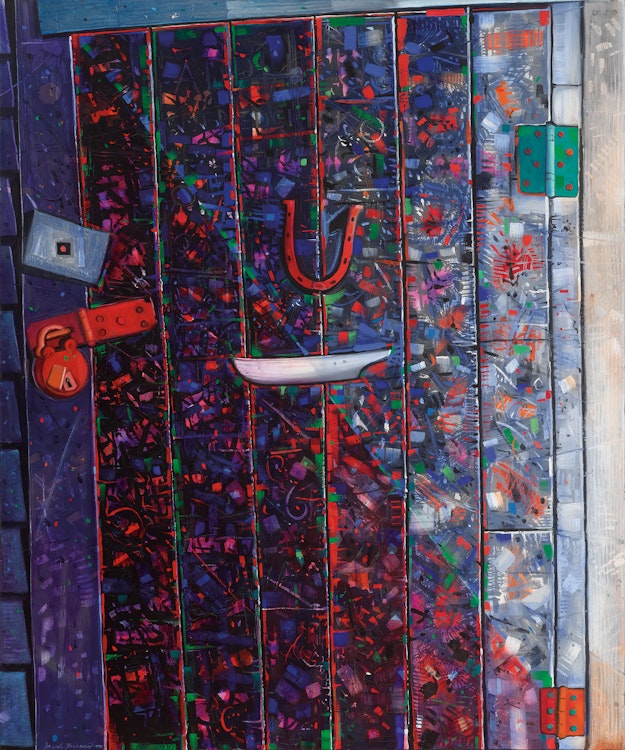Ephraim Kelloway's Night Door, 1989-1990 by David Lloyd Blackwood

David Blackwood
Ephraim Kelloway's Night Door, 1989-1990
oil on canvas
signed and dated 1990 lower left; signed, initialled (twice), titled, dated 1989-1990 and inscribed "painted Feb 18 1990" on the reverse
48 x 40 in ( 121.9 x 101.6 cm )
Auction Estimate: $80,000.00 - $120,000.00
Price Realized $132,000.00
Sale date: November 27th 2024
Collection of the Artist
Acquired directly from the Artist by the present Private Collection, Ontario
Lisa Moore, 'David Blackwood: Memory and Light', "Newfoundland Quarterly", Vol. 98-3, 2006
Abbozzo Gallery, "David Blackwood Illumination: Ephraim Kelloway’s Door", Toronto, 2010, pages 3, 4, 12
"Communications" with Anita Blackwood, September 2024
In the late 1950s, Ephraim Kelloway painted his shed door green. In a 2006 interview with Lisa Moore, Blackwood remembered: “A couple of weeks later he painted it again. Once he used stovepipe paint and the door was silver. Another time it was fluorescent pink. Gradually he began to add bits and pieces to the surface, a horseshoe and lettered tin. The surface paint peeled, and the texture became a part of the overall effect.” When David Blackwood left Newfoundland in September 1959 to attend the Ontario College of Art in Toronto, Ephraim Kelloway stopped painting the shed door and the artist recalled, “the elements took over where he had left off – transforming the door slowly over the next several years as it shed its coats of many colours.”
When the painter’s brother Edgar decided to try and become a lobster fisherman, Ephraim Kelloway sold the Blackwood family the small shed for $25, a place for Edgar to store his lobster gear. The shed was moved off the Kelloway land and onto the Blackwood property, close to David Blackwood’s Wesleyville studio. Blackwood’s summer visits to Newfoundland led him to examine the door more closely, recalling its long, layered and colourful history. The artist composed his first drawings, and an etching inspired by the door in 1981. Watercolours followed, and eventually the first paintings in 1985.
A devoted and celebrated printmaker for years, Blackwood recalled his teacher, artist Jock Macdonald telling him that “every artist needs a subject.” It dawned on him suddenly that “here it was, in front of me... the door became my gateway into an exploration of large-scale painting – and the results were an epiphany.”
Blackwood recalls: “I embarked on a major series of paintings that were exhibited in Toronto in 1990. By the year 2000 a significant amount of work had been devoted to the door in a variety of media, and its image had been widely reproduced in exhibition catalogues and posters. Strangely, the door was attracting a following, and people began visiting Wesleyville to look at it, photograph it, and even write about it.” After it was removed from the shed during an unsuccessful theft in 2002, the door moved into David Blackwood’s studio, where it remained for the rest of his life.
In an interview, Blackwood relayed the importance of the Kelloway shed door to his life and work, saying, “After years of contemplation, it has become a touchstone for me, an object dense with layers of both personal and universal meaning that is so very symbolic of Newfoundland. It is something I relate deeply to; an icon of unlimited potential that continues to provide me with an architectural framework on which to hang all the components of painting.”
As Ken Forsyth suggests, “The image of any door carries with it a host of symbolic references and associations, suggesting a passage or journey from one place to another.” "Ephraim Kelloway’s Night Door" summons mystical elements with the simple fisherman’s charms decorating the door. These charms were meant to ward off possible evil and misfortune at sea. A universal symbol of good luck, the horseshoe, hangs protectively over the half-model cut-out of a boat. The appearance of these features in the works of the Door series highlights Blackwood’s awareness of the conjunction of magic and meaning, invoking a form of protective magic.
Mrs. Anita Blackwood has noted that the artist, “Enjoyed depicting the night skies. He was fascinated by light, light of the landscape, moonlight, starlight, clouds, the way the sun breaks... it was an interest that we shared; while driving we would discuss the light on the landscape, clouds, movement, wind and rain. While sitting on our terrace in Port Hope, we would look at the sky and wind in the trees. David was raised in an environment where weather was a primary focus... his mother always fretted about his father being at sea when the weather turned threatening. I think the focus of weather was something ingrained in him from childhood.”
Decades of fascination with the simple object of a door has resulted in a series of monumental and pivotal works by Blackwood. The works in the series allow time, memory and experience to flow together through the door as a relic or reliquary, while simultaneously granting the past, present and future to exist in a transcendent reality.
Share this item with your friends
David Lloyd Blackwood
(1941 - 2022) OSA, RCA, Order of Canada
Born in Wesleyville, Bonavista Bay, Newfoundland, one of the major sealing towns of that province, he is a descendant of a long line of master mariners. Blackwood was awarded a Government of Newfoundland Centennial scholarship to study at the Ontario College of Art in Toronto under Carl Schaefer, John Alfsen, H.W.G. MacDonald and Frederick Hagan. He went on to become Art Master at Trinity College School in Port Hope, Ontario. In 1969, Blackwood became the first artist-in-residence at Erindale College, University of Toronto, Mississauga.
David Blackwood uses his background on the East coast of Canada to create grande visual narratives reflecting both the landscape and culture of the province with an emphasis on combining the history, legends, and myths of settlement and developing culture of Newfoundland. He is best-known for his colour etchings with aquatint. His work was used to provide illustrations for Farley Mowat’s “Wake of the Great Sealers”, a collection of stories about the heroic Newfoundlanders who braved the icy seas of the treacherous North Atlantic in search of seals. Driven by hard times at home it was the only hope many of the men had of making money to feed their families. Men perished when their ships went down during wintry gales. Blackwood, a native of a sealing town himself, and a descendent of fishing skippers and sealing captains, provides Mowat’s stirring text with equally stirring and poetic figurative drawings and prints.
Blackwood was awarded the Order of Canada in 1993 in recognition of his work contributing to and preserving the cultural life and heritage of Canada through his artwork. At the Art Gallery of Ontario, the Blackwood Research Centre within the Morin Gelber Print and Drawing Centre was created after a major acquisition of the artists works in 2000. The museum also elected Blackwood as its honourary Chairman in 2003, the first practicing artist to hold this position. In the same year, he was awarded the Order of Ontario.
As one of Canada's most celebrated print-makers, David Blackwood's works are part of significant Canadian and international private and corporate collections including The Royal Collection, Windsor Castle, the Uffizi Gallery, Florence, the Art Gallery of Ontario and the National Gallery of Canada.
Sources: "A Dictionary of Canadian Artists, Volume I: A-F", compiled by Colin S. MacDonald, Canadian Paperbacks Publishing Ltd, Ottawa, 1977

